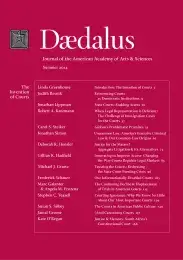Our Informationally Disabled Courts
In order to carry out their functions of deciding particular cases and developing legal rules and principles, courts need information: not just information about the law, but also factual information about the particular matter in controversy and about the world in general. The way in which courts are structured, however, makes it more difficult for them to obtain the information they need than it is for most other public decision-making institutions. As the world becomes more complex, and as sophisticated scientific, technical, and financial information becomes more central to litigation and to the judicial function, the systemic disabilities of the courts in obtaining the information they need become more apparent and increasingly more problematic.
What makes a court a court? The question is important, but it lacks an obvious answer. We might distinguish courts from other decision-making institutions in terms of being staffed principally by those with legal training. And thus insofar as lawyers and judges occupy a sociologically discrete segment of professional culture,1 courts can be distinguished by virtue of their sociological differentiation. Or we might begin with the fact that courts make decisions with procedures unlike those of other decision-making environments. The modal number of parties in a court case is two; the modal outcome has a winner and loser; and decisions are typically made by judges or other arbiters with no interest in the outcome. In these and various other ways, courts’ procedures differ from those of legislatures, administrative agencies, executive officials, the military, and private corporations. Additionally, or perhaps alternatively, law schools purport to train their students in the arcane art of thinking like a lawyer,2 and so what differentiates courts may be the fact that they reach their decisions via methods of thinking and reasoning that differ from those we see in other environments.
Each of these ways of differentiating courts–sociological, procedural, and methodological–constitutes part of a complete account of how we should characterize and understand them, but my focus here will be on still another criterion, one we can call informational differentiation: the array of information courts use in making decisions. This essay will concern a particular dimension of informational differentiation–the methods by which courts obtain factual, scientific, and technical information, and the potential flaws inherent in those methods.
It is common to think of courts in terms of their outputs: the decisions they make and the opinions they write. But these decisions are based on inputs, which fall into two broad categories. The first of these is the law. For some lawyers, judges, and scholars, the category of law is (and should be) narrow, encompassing little more than statutes, constitutional provisions, reported court cases, and the conventional methods of legal reasoning and interpretation of standard legal materials.3 Others understand the law as including not only the foregoing, but also a broad range of moral, political, and pragmatic factors.4 And although the divisions between those holding broad and narrow conceptions of law are profoundly important, this should not obscure the equal or greater importance of the other broad category of court inputs: the world of fact.
. . .
